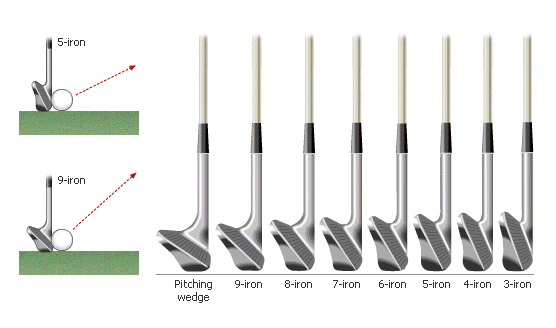- This topic is empty.
-
Topic
-
Golf clubs are designed with a specific purpose in mind, based on the type of shot that the golfer intends to make. There are three main types of golf clubs: woods, irons, and putters.
Woods are designed to hit the ball long distances off the tee or from the fairway. They are called “woods” because they used to be made of wood, but nowadays they are usually made of metal. Woods typically have a large, round head and a long shaft.
Irons are used for a variety of shots, from hitting the ball off the fairway to getting out of the rough or a Bunker (sand trap). Irons have a smaller head than woods and a shorter shaft. The number on the iron corresponds to the angle of the clubface, with lower numbers having a more vertical face and higher numbers having a more horizontal face.
Putters are used for short shots on the green, where precision and accuracy are key. Putters have a flat face and a short shaft, and come in a variety of shapes and sizes.
Golf club have evolved over time, with improvements in technology and materials. Today, many golf clubs are designed using computer-aided design (CAD) software and are made from lightweight materials like titanium, graphite, and carbon fiber to optimize performance.
A driver, 3 wood, and 5 wood are all types of golf clubs, but they have different characteristics and are designed for different purposes.
A driver is typically the longest club in a golfer’s bag and is used to hit the ball off the tee on long par 4s and par 5s. The head of a driver is large and round, usually made of metal, and has a low loft angle (around 9-13 degrees). The low loft angle of a driver allows the golfer to hit the ball a long distance but with a lower trajectory. A driver is also sometimes called a “1 wood.”
A 3 wood is a type of fairway wood that is designed for longer shots off the fairway or rough. The head of a 3 wood is smaller than a driver but larger than a 5 wood, and has a slightly higher loft angle (around 15-18 degrees). The higher loft angle of a 3 wood makes it easier to get the ball in the air and can also help with accuracy. A 3 wood is also sometimes called a “3 metal.”
A 5 wood is another type of fairway wood, but with a higher loft angle than a 3 wood (around 20-22 degrees). A 5 wood is designed for even shorter shots off the fairway or rough, or for hitting the ball out of bunkers. The head of a 5 wood is slightly smaller than a 3 wood but larger than a 7 wood or higher-numbered fairway wood. A 5 wood is also sometimes called a “5 metal.”
Irons are typically numbered from 1 to 9, with lower numbers corresponding to clubs with lower lofts (more vertical faces) and longer shafts, and higher numbers corresponding to clubs with higher lofts (more horizontal faces) and shorter shafts.
The following is a general guide to the angles of each type of iron:
- 1 iron: Around 16-18 degrees of loft
- 2 iron: Around 19-22 degrees of loft
- 3 iron: Around 20-24 degrees of loft
- 4 iron: Around 25-28 degrees of loft
- 5 iron: Around 28-32 degrees of loft
- 6 iron: Around 32-36 degrees of loft
- 7 iron: Around 36-40 degrees of loft
- 8 iron: Around 40-44 degrees of loft
- 9 iron: Around 44-48 degrees of loft
Note that the exact angles of irons can vary between different club manufacturers and models, and that these numbers are just a general guide. Some golfers may choose to carry other types of irons, such as a pitching wedge (P) (typically around 48-52 degrees of loft) or a gap wedge (around 50-54 degrees of loft), which are designed for specific types of shots around the green.
Sand Wedge 56° of loft 80-100 yards carry Lob Wedge 60° of loft 60-90 yards carry 
How far should you hit a golf ball with each club?
The distance that a golfer hits a ball with each club can vary widely depending on factors such as their physical abilities, swing technique, weather conditions, and the type of ball being used. Different golfers may hit the same club different distances.
Here is a rough estimate of the average distance a golfer might hit the ball with each club, based on a full swing:
- Driver: 230-290 yards (This is average for us men. The pros hit above 300 yards)
- 3-wood: 170-230 yards
- 5-wood: 150-210 yards
- 3-iron: 150-190 yards
- 4-iron: 140-180 yards
- 5-iron: 130-170 yards
- 6-iron: 120-160 yards
- 7-iron: 110-150 yards
- 8-iron: 100-140 yards
- 9-iron: 90-130 yards
- Pitching wedge: 80-120 yards (Some can hit 180 yards with a P)
- Sand wedge: 40-90 yards
Again, these are just general estimates, and actual distances can vary widely depending on the individual golfer and other factors. It’s always best to practice and get a sense of your own distances for each club.
- You must be logged in to reply to this topic.
